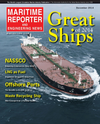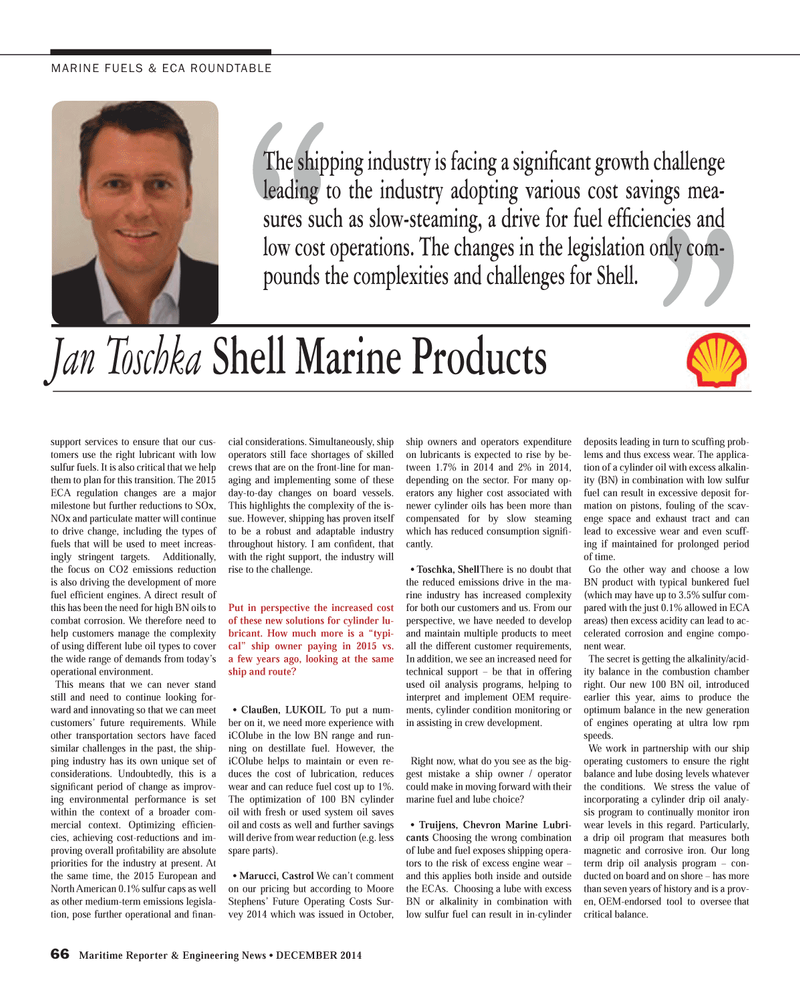
Page 66: of Maritime Reporter Magazine (December 2014)
Great Ships of 2014
Read this page in Pdf, Flash or Html5 edition of December 2014 Maritime Reporter Magazine
66 Maritime Reporter & Engineering News • DECEMBER 2014
MARINE FUELS & ECA ROUNDTABLE ” “
Jan Toschka Shell Marine Products
The shipping industry is facing a signifi cant growth challenge leading to the industry adopting various cost savings mea- sures such as slow-steaming, a drive for fuel effi ciencies and low cost operations. The changes in the legislation only com- pounds the complexities and challenges for Shell. support services to ensure that our cus- tomers use the right lubricant with low sulfur fuels. It is also critical that we help them to plan for this transition. The 2015
ECA regulation changes are a major milestone but further reductions to SOx,
NOx and particulate matter will continue to drive change, including the types of fuels that will be used to meet increas- ingly stringent targets. Additionally, the focus on CO2 emissions reduction is also driving the development of more fuel effi cient engines. A direct result of this has been the need for high BN oils to combat corrosion. We therefore need to help customers manage the complexity of using different lube oil types to cover the wide range of demands from today’s operational environment.
This means that we can never stand still and need to continue looking for- ward and innovating so that we can meet customers’ future requirements. While other transportation sectors have faced similar challenges in the past, the ship- ping industry has its own unique set of considerations. Undoubtedly, this is a signifi cant period of change as improv- ing environmental performance is set within the context of a broader com- mercial context. Optimizing effi cien- cies, achieving cost-reductions and im- proving overall profi tability are absolute priorities for the industry at present. At the same time, the 2015 European and
North American 0.1% sulfur caps as well as other medium-term emissions legisla- tion, pose further operational and fi nan- cial considerations. Simultaneously, ship operators still face shortages of skilled crews that are on the front-line for man- aging and implementing some of these day-to-day changes on board vessels.
This highlights the complexity of the is- sue. However, shipping has proven itself to be a robust and adaptable industry throughout history. I am confi dent, that with the right support, the industry will rise to the challenge.
Put in perspective the increased cost of these new solutions for cylinder lu- bricant. How much more is a “typi- cal” ship owner paying in 2015 vs. a few years ago, looking at the same ship and route? • Claußen, LUKOIL To put a num- ber on it, we need more experience with iCOlube in the low BN range and run- ning on destillate fuel. However, the iCOlube helps to maintain or even re- duces the cost of lubrication, reduces wear and can reduce fuel cost up to 1%.
The optimization of 100 BN cylinder oil with fresh or used system oil saves oil and costs as well and further savings will derive from wear reduction (e.g. less spare parts). • Marucci, Castrol We can’t comment on our pricing but according to Moore
Stephens’ Future Operating Costs Sur- vey 2014 which was issued in October, ship owners and operators expenditure on lubricants is expected to rise by be- tween 1.7% in 2014 and 2% in 2014, depending on the sector. For many op- erators any higher cost associated with newer cylinder oils has been more than compensated for by slow steaming which has reduced consumption signifi - cantly. • Toschka, Shell There is no doubt that the reduced emissions drive in the ma- rine industry has increased complexity for both our customers and us. From our perspective, we have needed to develop and maintain multiple products to meet all the different customer requirements,
In addition, we see an increased need for technical support – be that in offering used oil analysis programs, helping to interpret and implement OEM require- ments, cylinder condition monitoring or in assisting in crew development.
Right now, what do you see as the big- gest mistake a ship owner / operator could make in moving forward with their marine fuel and lube choice? • Truijens, Chevron Marine Lubri- cants Choosing the wrong combination of lube and fuel exposes shipping opera- tors to the risk of excess engine wear – and this applies both inside and outside the ECAs. Choosing a lube with excess
BN or alkalinity in combination with low sulfur fuel can result in in-cylinder deposits leading in turn to scuffi ng prob- lems and thus excess wear. The applica- tion of a cylinder oil with excess alkalin- ity (BN) in combination with low sulfur fuel can result in excessive deposit for- mation on pistons, fouling of the scav- enge space and exhaust tract and can lead to excessive wear and even scuff- ing if maintained for prolonged period of time.
Go the other way and choose a low
BN product with typical bunkered fuel (which may have up to 3.5% sulfur com- pared with the just 0.1% allowed in ECA areas) then excess acidity can lead to ac- celerated corrosion and engine compo- nent wear.
The secret is getting the alkalinity/acid- ity balance in the combustion chamber right. Our new 100 BN oil, introduced earlier this year, aims to produce the optimum balance in the new generation of engines operating at ultra low rpm speeds.
We work in partnership with our ship operating customers to ensure the right balance and lube dosing levels whatever the conditions. We stress the value of incorporating a cylinder drip oil analy- sis program to continually monitor iron wear levels in this regard. Particularly, a drip oil program that measures both magnetic and corrosive iron. Our long term drip oil analysis program – con- ducted on board and on shore – has more than seven years of history and is a prov- en, OEM-endorsed tool to oversee that critical balance.
MR #12 (66-73).indd 66 12/2/2014 2:46:57 PM

 65
65

 67
67
